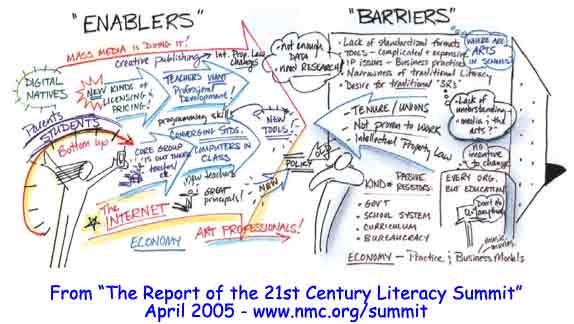A Global Imperative: The Report of the 21st Century Literacy Summit, is the result of an April 2005 meeting held in San Jose, California. The meeting was convened by the George Lucas Educational Foundation and Adobe Systems, and the report published by The New Media Consortium (www.nmc.org) based in Austin, Texas.
The 32 page report (available as a PDF file) is distributed under a Creative Commons Attribution-NonCommercial-NoDerivs license, which is great to see for a publication like this. (Good modeling of intellectual property sharing.) The 300 page Advance Readings for the Summit (PDF) is a superb literature review of seminal work and authors in the area of digital literacy.
Here are a few highlights from the summit report that stood out when I read it:
Unlike the traditional notions of language and literacy, which are primarily unimodal and textual, this new form of communication and self-expression occurs multimodally, incorporating visual and aural elements with textual elements, and an immediacy which itself is a dimension of the new language. (Executive Summary, p. 1)
…in countries around the world, researchers and educators are realizing that the current models of education are failing us…[often] today’s curricula do not meet their needs [those of digital natives in our classrooms], and too often school is the least engaging part of a student’s day. (A Global Imperative, p. 2)
The definition crafted by this working group of “digital literacy” is an excellent one:
21st century literacy is the set of abilities and skills where aural, visual and digital literacy overlap. These include the ability to understand the power of images and sounds, to recognize and use that power, to manipulate and trans- form digital media, to distribute them pervasively, and to easily adapt them to new forms. (A Global Imperative, p. 2)
These paragraphs in the section, “What does a world that values 21st century literacy look like” (p. 7) are right in line with the work I am doing on “Publish At Will”:
The essential characteristic of this world is that it embraces 21st century literacy broadly. Communication is multi-dimensional, engaging, and increasingly unbound to text. Creativity is valued broadly, and success is associated with the ability to articulate ideas using not only words, but also images and sounds.
Education is optimized for multi-tasking and tailored to each learner. Schools incorporate the new literacies across the curriculum, and use them to more fully engage students, articulate ideas, and demonstrate concepts. New tools, easy-to-use and widely available, allow the skills imbedded in 21st century literacy to be refined throughout a child’s educational experience.
I agree with the following statement which addresses intellectual property issues:
The students who are following those teachers into college are themselves digital natives, part of a remix culture in which traditional norms around copyright and intellectual property have become impediments to creativity. (p. 7)
This image illustrating enables and barriers to this vision of digital literacy promotion says a great deal (p. 9):

This quotation is critical to analyze and understand:
Early in the discussions, it became clear that the forces at play were complex. In several cases, the same factors could fuel progress or inhibit it, or even both, depending on how they were actualized.
Are we and the organizations we work for serving as constructive change agents in our environment, enabling processes of change promoting digital literacy education to advance, or are we serving as barriers?
USC’s Institute for Multimedia Literacy (www.iml.annenberg.edu) referenced in the report on page 6 is amazing. Every school needs a program like the “Honors in Multimedia Scholarship,” which can be integrated into any academic major.
Thanks to Susan Brooks-Young’s post in the School Technology Leadership blog for bringing this important report to my attention.
If you enjoyed this post and found it useful, subscribe to Wes’ free newsletter. Check out Wes’ video tutorial library, “Playing with Media.” Information about more ways to learn with Dr. Wesley Fryer are available on wesfryer.com/after.
On this day..
- Tips for Using Jamboard – 2022
- Provide Family Tech Support FREE with Teamviewer – 2020
- Teaching iPad Videography From 3800 Miles Away – 2014
- Copying the Textbook is NOT an Acceptable Assignment – 2012
- New Video Editing Options with YouTube’s Browser-based Editor and Magisto – 2011
- Making the Case for Sharing Curriculum Openly Online – 2011
- Radio Program for Playing with Media? – 2011
- World Expo Shanghai (a VoiceThread digital story) – 2010
- Create animated cartoon videos with GoAnimate #learning2cn – 2010
- Takeaways from the 21st Century Learning @ Hong Kong Conference – 2009
